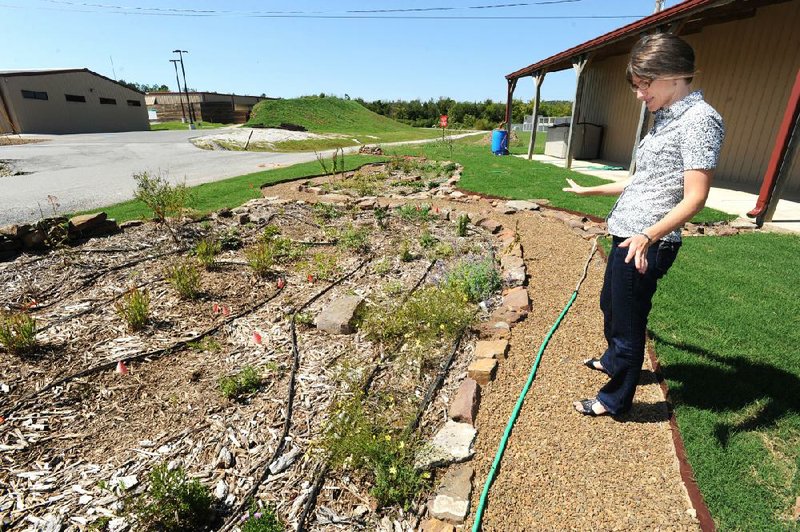LITTLE ROCK — A few years ago, Amy Wilson’s lawn on the east side of Mount Sequoyah in Fayetteville had a water runoff problem.
“I had severe erosion in my front yard,” she said.
As director of public affairs for the Beaver Water District, Wilson had been involved in rain garden conservation projects designed to fix exactly that problem. So even though she rarely attempts major home improvement projects herself, Wilson decided four years ago to build her own rain garden.
“I was excited to think it could work for me,” she said. She enlisted a friend with a backhoe, bought plants and mulch for less than $250, planted everything herself and sat back to see what would happen.
Building more rain gardens like Wilson’s in Northwest Arkansas is the goal of a $350,000 federal and state grant-funded project under way now in the Illinois River and the Beaver Lake watersheds in Benton and Washington counties.
The Illinois River Watershed Partnership and the Beaver Water District are overseeing the grants from the federal Environmental Protection Agency and the Arkansas Natural Resources Commission for volunteers to build demonstration rain gardens. The goal is to educate the public about how to control storm water runoff pollution. The demonstration gardens must be located on municipal property, or at schools, churches or “quasi-public” spaces.
Organizers hope those gardens will inspire homeowners like Wilson to spend time and money building similar projects in their own yards.
The Rain Garden Project’s goal is to build 60 of the low lying gardens, decorated with native plants and mulch that soak up storm water runoff.
Without the gardens, excess storm water can pass untreated into streams, said Becky Roark, rain garden resource specialist with the Illinois River Watershed Partnership. Runoff water is a significant pollutant, she said, carrying contaminants such as fertilizer, pet waste, bacteria, and motor vehicle grease and oil.
The project got under way on July 1, 2011. The deadline to finish 30 rain gardens in the Illinois River Watershed and 30 in the Beaver Water District is June 30, 2014.
“As of right now, we’ve done 18,” Roark said. “That means we have 42 to go.”
The Rain Garden Project offers Rain Garden Academy workshops to help people learn more about the gardens and apply for a grant.
“The idea is to demonstrate this and get homeowners involved,” said Roark, whose Illinois River Watershed Partnership group is overseeing the Rain Garden Project for both watersheds. “We have educational material to teach people to look at these and go home and say, ‘I can do that.’”
Rain gardens work by trapping, spreading out and soaking up runoff water. They are usually at least 10 feet from buildings, but not too far from impervious surfaces where water runs off.
Most people prepare a space of 100 to 500 square feet, or about one-third the size of the roof, driveway or surface that needs better drainage. They dig down 6 to 8 inches and often add a mixture of sand, compost and top soil to the remaining dirt to improve absorption and filtration, Roark said. They also add native plants that are drought-tolerant but can handle standing water for 24 to 48 hours. “Their root systems help the water percolate,” Roark said.
The typical cost is $3 to $4 per square foot.
Rain gardens usually require little upkeep after the plants are established, Roark said. They also don’t need as much irrigation as lawns or traditional gardens, so they can cut a homeowner’s water bill.
Studies have shown that rain gardens have the potential to remove 80 percent to 90 percent of phosphorus, a common element found in storm water, Roark said. Phosphorus can cause excessive algae growth that can harm the quality of the water and aquatic life in lakes, streams and rivers.
The Illinois River Watershed has been the target of a long-running civil lawsuit in federal court in Tulsa between the state of Oklahoma and Springdale-based Tyson Foods Inc. and five other Arkansas poultry companies.
At issue is phosphorus from poultry manure that Oklahoma officials contend washes off farmland and pollutes the Illinois River. The trial concluded in February 2010. U.S. District Judge Gregory Frizzell has yet to issue a ruling.
Although rain gardens improve phosphorus runoff, they are designed for urban and suburban landscapes instead of large, rural acreage, Roark said.
In Wilson’s front yard in Fayetteville, she said, she’s seen dramatic improvements since building her rain garden.
“Where the extreme washing out was happening, this garden stopped it,” Wilson said. “I was amazed. It does work.”
Arkansas, Pages 7 on 09/24/2012

